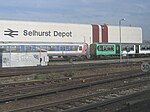BRIT School

The BRIT School is a British performing and creative arts school located in Selhurst, Croydon, England, with a mandate to provide education and vocational training for the performing arts, music, music technology, theatre, musical theatre, dance, applied theatre, production arts and the creative arts film and media production (FMP), interactive digital design (IDD), visual arts and design (VAD). Selective in its intake but free to attend, the school is notable for its celebrity alumni.Opened on 22 October 1991 under the CTC programme, the school is funded by the British Government with support from the British Record Industry Trust and other charity partners and donations and maintains an independent school status from the local education authority.
Excerpt from the Wikipedia article BRIT School (License: CC BY-SA 3.0, Authors, Images).BRIT School
The Crescent, London Selhurst (London Borough of Croydon)
Geographical coordinates (GPS) Address Phone number Website External links Nearby Places Show on map
Geographical coordinates (GPS)
| Latitude | Longitude |
|---|---|
| N 51.3899 ° | E -0.0914 ° |
Address
The BRIT School (BRIT School for Performing Arts and Technology)
The Crescent 60
CR0 2HN London, Selhurst (London Borough of Croydon)
England, United Kingdom
Open on Google Maps









